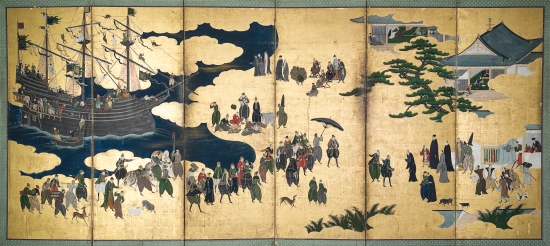We know that ancient Japanese gold leaf artists were truly masters of their craft - their works are ornate and delicate.
What remains a mystery is how artifacts were gilded with gold leaf that was hand-beaten to the nanometer scale. Gold leaf refers to a very thin sheet made from a combination of gold and other metals. It has almost no weight and can only be handled by specially designed tools. Even though the ancient Egyptians were probably the first to gild artwork with it, the Japanese have long been credited as being able to produce the thinnest gold leaf in the world.
In Japanese traditional painting, decorating with gold leaf is named Kin-haku, and the finest examples of this craft are the Namban folding screens, or byobu. These were made during the late Momoyama (around 1573 to 1603) and early Edo (around 1603 to 1868) periods.

Nanban trade screen, c. 1620–40 Six-panel screen; ink, color, gold and gold leaf on paper. The Avery Brundage Collection (B60D78+) © Asian Art Museum, San Francisco
Study leader Sofia Pessanha of the Atomic Physics Center of the University of Lisbon in Portugal used X-ray fluorescence to examine
six ancient Namban paper screens
that are currently either part of a museum collection or in a private collection in Portugal. Four screens belong to the Momoyama period, and two others were decorated during the early Edo period.
The researchers used various X-ray fluorescence spectroscopy techniques to test the thickness and characteristics of the gold layers. The method is completely non-invasive, no samples needed to be taken, and therefore the artwork was not damaged in any way. Also, the apparatus needed to perform these tests is portable and can be done outside of a laboratory.
The gilding was evaluated by taking the attenuation or weakening of the different characteristic lines of gold leaf layers into account. The methodology was tested to be suitable for high grade gold alloys with a maximum of 5 percent influence of silver, which is considered negligible.
The two screens from the early Edo period were initially thought to be of the same age. However, Pessanha's team found that gold leaf on a screen kept at Museu Oriente in Lisbon was thinner, hence was made more recently. This is in line with the continued development of the gold beating techniques carried out in an effort to obtain ever thinner gold leaf.
"This simple comparison allowed establishing a timeline between the manufacture of two pieces attributed to the same period, proving that X-ray fluorescence techniques can be an important asset in the dating of artworks," says Pessanha.






Comments